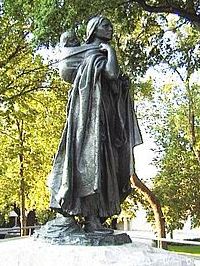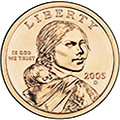» posted on Sunday, May 13th, 2012 by Linda Lou Burton
Mother First
 Linda Burton posting from Boise, Idaho – There’s a trailer running on TV now about a new movie – What to Expect When You’re Expecting – and the ad contains a line that really tickles me. “You don’t know the meaning of love until you’ve wiped somebody’s butt.” Funny how that works. It’s Mother’s Day and I’m remembering Mothers I Have Known. My Mom, of course, and my Ma-in-law; without them my family as it is today would not exist. There’s my two Grandma’s, who saw me as a Perfect Child. There’s Aunt Verla, and Aunt Clara, who mothered me like I belonged to them. There are my daughters-in-law, who gave me a more precious gift than money can buy – grandchildren! And there are my sons, who made sure I knew the meaning of love. That was in the days before Pampers too. But heck, I’m thinking as I sit in Idaho, Sacajawea didn’t have Pampers either. Did you know that she was born just north of here?
Linda Burton posting from Boise, Idaho – There’s a trailer running on TV now about a new movie – What to Expect When You’re Expecting – and the ad contains a line that really tickles me. “You don’t know the meaning of love until you’ve wiped somebody’s butt.” Funny how that works. It’s Mother’s Day and I’m remembering Mothers I Have Known. My Mom, of course, and my Ma-in-law; without them my family as it is today would not exist. There’s my two Grandma’s, who saw me as a Perfect Child. There’s Aunt Verla, and Aunt Clara, who mothered me like I belonged to them. There are my daughters-in-law, who gave me a more precious gift than money can buy – grandchildren! And there are my sons, who made sure I knew the meaning of love. That was in the days before Pampers too. But heck, I’m thinking as I sit in Idaho, Sacajawea didn’t have Pampers either. Did you know that she was born just north of here?
Yes, in about 1788, a Shoshone girl. You’re familiar with the story – she was kidnapped as a child, taken to North Dakota, and later became the “wife” of French-Canadian trader Toussaint Charbonneau. Truth is, she was a slave; Charbonneau bought her, along with another Shoshone woman. When Lewis and Clark prepared for their historic Expedition west, they hired Charbonneau as a guide on the condition his Shoshone “wife” come too. She was 15 years old and 6 months pregnant at the time; they wintered at Mandan in North Dakota where son Jean-Baptiste Charbonneau was born in 1805.
 Sacajawea slung her baby over her back and off they went come spring; as the only woman on the trip she not only took care of baby’s needs, she cooked, foraged for food, sewed, and cleaned the clothes of the men. She also was the nurse, using herbs and other natural means to treat injuries and illnesses. Trading with Indian tribes along the way, especially for horses, was essential to the Expedition, and Sacajawea spoke several native languages. She didn’t speak English, but she translated to Hidatsa to Charbonneau, who translated to French for Labiche (a member of the Expedition), who translated to English for Lewis and Clark. Imagine those sessions! Sacajawea also is credited in Clark’s journal with saving critical records and instruments from being lost overboard in a storm. All this, while taking care of baby.
Sacajawea slung her baby over her back and off they went come spring; as the only woman on the trip she not only took care of baby’s needs, she cooked, foraged for food, sewed, and cleaned the clothes of the men. She also was the nurse, using herbs and other natural means to treat injuries and illnesses. Trading with Indian tribes along the way, especially for horses, was essential to the Expedition, and Sacajawea spoke several native languages. She didn’t speak English, but she translated to Hidatsa to Charbonneau, who translated to French for Labiche (a member of the Expedition), who translated to English for Lewis and Clark. Imagine those sessions! Sacajawea also is credited in Clark’s journal with saving critical records and instruments from being lost overboard in a storm. All this, while taking care of baby.
Sacajawea got two rewards while on the Expedition – she found her brother when they got to Idaho, he was chief of the first Shoshone tribe they met; an emotional reunion. And while they were in Oregon, she was able to see the “Great Waters” of the ocean, something her people dreamed of, but few got to do. She wasn’t paid for her services however; when the Expedition returned home, Charbonneau was paid $500.33 and given 320 acres of land; Sacajawea received nothing. She died of a fever at 25.
 In 2000 a US dollar gold coin was issued featuring Sacajawea, with her infant Jean-Baptiste peering over her shoulder. He is the only child ever featured on a US coin. In 2002 the Idaho Federation of Business and Professional Women named her Idaho’s First Professional Woman. There are claims that no woman in the US has more statues in her honor than Sacajawea; public schools, mountain peaks, streams and lakes are named for her. But first of all, she was somebody’s mother, learning the meaning of love.
In 2000 a US dollar gold coin was issued featuring Sacajawea, with her infant Jean-Baptiste peering over her shoulder. He is the only child ever featured on a US coin. In 2002 the Idaho Federation of Business and Professional Women named her Idaho’s First Professional Woman. There are claims that no woman in the US has more statues in her honor than Sacajawea; public schools, mountain peaks, streams and lakes are named for her. But first of all, she was somebody’s mother, learning the meaning of love.
http://www.usmint.gov/mint_programs/?action=golden_dollar_coin

